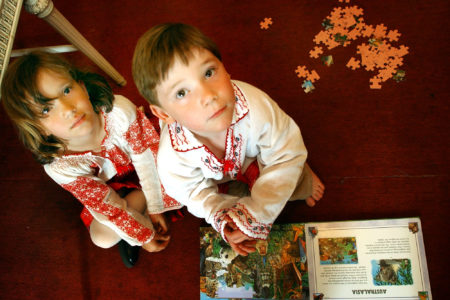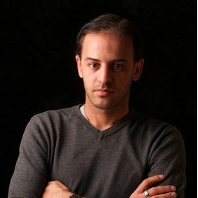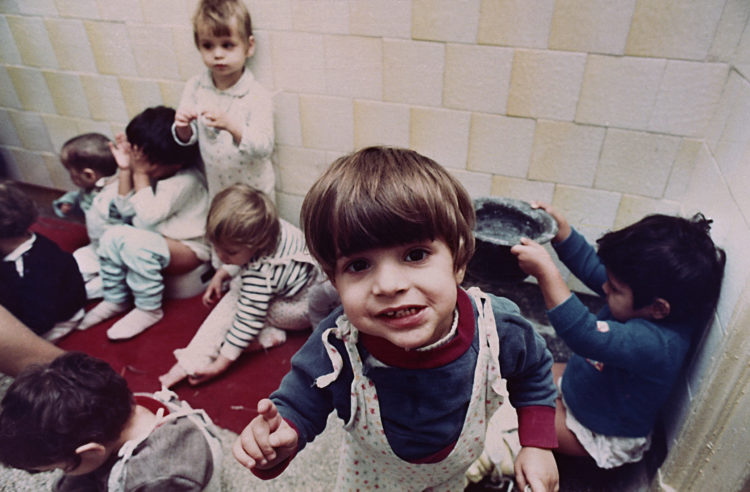If the first rule of nonfiction is “write what you know,” then Melissa Fay Greene has embraced this principle like few others.
She has spent her career chronicling the interior lives of families on the outside — those often struggling to just get through the day. For perspective, she need look no further than her own household of nine children — four biological, one adopted from Bulgaria and four from Ethiopia — to understand the complexities of families that defy the conventional mold. In doing those intimate stories, Greene doesn’t shrink from one simple fact: That those whom are most precious to us can also be the most challenging. She builds them on a foundation of rock-solid reporting, heart-tugging prose and a dollop of humor.
All that is on display in her sweeping story in the July/August issue of the Atlantic, “Can an Unloved Child Learn to Love?” Greene used the 30th anniversary of the fall of Communist dictator Nicolae Ceausescu as her hook, allowing her to drill down into what happened to the thousands of kids warehoused in Romanian orphanages during his regime, deprived of human contact and affection before being adopted by unprepared American parents who naively believed that love was enough.
She found Izidor Ruckel, a 39-year-old Romanian adoptee living in Denver, and his adoptive parents, Marlys and Danny Ruckel of San Diego, to examine the lingering difficulties facing many of those orphans and their families. The result takes readers far beyond the usual feel-good, airport “welcome” stories on adoption; Greene dares lead us, without flinching, into the realm of reality.
Finding a small example to tell a big story

Greene, a Georgia native who now lives with her family in Atlanta, has always pushed beyond the superficial. She is the author of six books of nonfiction, and a two-time National Book Award finalist. Her first book, “Praying for Sheetrock” (1991), examined how one black community in rural Georgia threw off two centuries of oppression; it was named one of the Top 100 Works of American Journalism of the 20th Century by a panel of experts convened by New York University. She has taught as the Kirk Writer-in-Residence at Agnes Scott College in Decatur, Georgia.
As she wrote in the introduction of “Sheetrock,” she teaches her students to look for “large and important things happening in a very little place,” an approach she used when she profiled one Georgia county to illuminate the rise of Civil Rights and the dismantling of the “good ol’ boy” era.
Said Greene: “That’s been the goal with a lot of my work, including The Atlantic article (about Romania adoptees), in which a story of the crimes of a megalomaniac...is told, in part, through the eyes of a child survivor.”
I have long been a fan of Greene’s work. And as an adoptive mother of a foreign-born child, I was especially interested in how she tackled a subject that can be fraught with sensitive issues of sourcing, access, ethics and exposure. Our interview has been edited for length and clarity. After our q&A, we offer glimpses of some of the journalism that has inspired Greene.
You are writing about a very nebulous subject — attachment. What were some of the challenges of reporting on something that most people can’t even describe?
We fling around the word “attachment” lightly to describe bonds of affection among people of any age. I quickly learned that child development experts define “the attachment relationship” more narrowly as the two-way relationship between a baby and her primary caregiver that sets the stage for all future development. “A positive secure attachment relationship between infant and caregiver sets the infant up for a lot of good things to happen in life,” Dr. Martha Pott at Tufts told me.

I wanted to investigate the opposite: what happens when a baby is not offered the chance to form an attachment relationship with an affectionate, responsive caregiver. Can such a child ever learn to love? Specifically, what happened to the tens of thousands of children neglected during the Soviet-Romanian regime of Nikolai Ceausescu in the mid-20th century? Is there a cut-off point — a “sensitive period” — after which children deprived of attachment relationships will be unable to form close bonds of friendship and love?
So, I ventured onto this melancholy landscape of what life might look like for adults whose infancies were defined by indifference and neglect. I found terrific experts and scientists, like the Bucharest Early Intervention Project (BEIP), and including Dr. , whose longitudinal research sought answers to questions about whether cognitive/emotional “doors” ever “close” in children denied attachment relationships.
The key was whether I could find a survivor of one of the institutions who could take me deeper than the science and tell me what it was like growing up in there, behind the bars and barbed wire, in chaotic rooms, essentially alone. My hope was that I could answer the implicit question — ‘Can a person unloved in childhood ever learn to love?’ — on both the scientific plane and the personal. The latter was harder.
How did you find Izidor Ruckel? Did you interview a lot of subjects before you settled on him?

I’d heard Izidor’s name over the years. My husband and I adopted a little boy from a Bulgarian orphanage in 1999; the world of Eastern European adoptees and their American families was small, and Izidor, who self-published a memoir in 2002, at 22, grew to be something of a spokesman for his cohort.
I interviewed other Romanian-adoptive families before I could locate Izidor. Several exemplified the findings that children removed from orphanages before their second birthdays can do quite well. I interviewed some blissfully happy families who’d whisked home young babies from Romanian hospitals largely unscathed. I found other adult survivors who’d been so harmed by the deprivation that they couldn’t capably relay their stories to me.
I found the perfect family, with three adult sons adopted out of “Home Hospitals for Irrecoverable Children,” and their parents were open to having me visit, but the young men felt finished with Romania, didn’t want to talk about it anymore with anyone. I spent a lot of time last summer thinking this article wasn’t going to happen. There was no story, no narrative arc, no heart.
And what happened when you found Izidor?
Everything changed. From our first phone conversation, I was floored by his detailed memory, his chilling assessment of what had been done to him, and his openness to talking.
He, in a way, exemplifies children discussed by Dr. Charles Zeanah, of Tulane, in the article: the kids whose material provisions in an orphanage were sufficient to allow them to achieve normal IQs, but whose neglect left them attachment-impaired anyway.
Izidor introduced me to Christina, and old friend from the orphanage, and I flew to California and Colorado last fall to visit Izidor, Christina and their families. Interviewing an adult with cognitive challenges is tricky; I proceeded carefully with Christina, 41, as if interviewing a young teenager, and in the company of her mom. And, honestly, interviewing adoptive parents can be delicate, too, especially when they’ve faced steep challenges. A great many parents who, in the 1990s, adopted Romanian orphanage children found their lives turned upside-down.
Did you disclose your own personal story?
I think that my being an adoptive mom made it easier for them to trust me to handle their stories gently and respectfully, and with the understanding that ‘Yes, it’s been tough; yes, we love our kids.’
I reviewed their quotes with them before publication, having promised the adoptive parents that they could change their minds before publication and become anonymous. I believe that allowed folks to share more openly. One woman, a psychotherapist, told me her marriage had crashed soon after she and her husband realized what they were facing with the kid they’d brought home from Romania — that is to say, a lifetime of being his caregivers. There wasn’t room to include her very poignant story, but if she’d decided at the last minute to become “an adoptive mother in New England,” or whatever, I would have obliged.
Your story is almost 9,000 words. Was it assigned or intended to be that long?
I invariably start out with the notion of being succinct. Crisp. Laconic!
But the more I take in, the more I learn and see and absorb, the more people I interview, the more I begin to see the thing as not a simple story at all but something almost ineffably complex and subtle, with deep historical roots and psychological resonance. I start lobbing more and more words at the situation, to try to bring it around.
I went wide-open, to be his guest for a day and see whatever he wanted to show me, and with the intent of absorbing as much as possible.
Nevertheless, the fact that this article swelled to 19,000 words by mid-December was not entirely my fault! Questions from editors filled my in-box, many in the scientific realm. Example: Why, they wondered, had humans evolved in such a way that a child requires just one, two, or three attachment figures — rather than a larger group of adults — in order to develop normally? It would have required a doctoral dissertation to do justice to some of these questions.
You then spend weeks rounding up more experts, reading more scholarly articles, scheduling more interviews, and trying to write something accurate, definitive, and yet sparkling and fascinating, while also succinct. The word count mounted well beyond the stage of anything publishable; and yet probing scientific questions from higher-ups continued to arrive. I grew fearful of checking my email, and depressed when I saw the return addresses.
Then you’re interviewing fantastic, important people, who give you their time and who offer tremendous quotes; and your heart sinks because you’re thinking: “This is fabulous and there’s no way there will be room for it.”
Do you have a writing routine?
I wake up early, head out for a swim or a walk of three or four miles with the three dogs, then write until early afternoon, or whenever the coffee stops making an impact. It’s infinitely easier than the days I juggled small children and their preschool schedules. Tuesday/Thursday 9-to-noon “Mothers Morning Out” didn’t give you time to do anything more than sit in the parking lot and cry.
Most people don’t have the luxury of 9,000 words and 10 months to work on a story. What advice would you give a reporter who might get two weeks and 3,000 words?
With 3,000 words, you wouldn’t throw such a tremendous net as “What happened to the generation of the Romanian orphanage survivors?” or “Can a person unloved in childhood ever still learn to love?”
But you could pursue a little-known finding, like (as an example from my story) neuropsychologist Dr. Ron Federici’s observation that, of the 9,000 adopted post-institutionalized adopted children he has seen in his practice over 30 years, roughly a quarter of them require round-the-clock care, even as adults. This means, of course, that there are adoptive parents who have been in the trenches since the early 1990s. You could build a fascinating 3,000-word piece around that.
The next step is to find a protagonist whose story you can tell. The very essence of a story is the journey of a protagonist — someone with whom your readers can empathize and identify.
Maybe you find a mom who, back in the day, facing infertility, wanted more than anything in life to raise a child. Maybe she imagined PTA meetings, school plays, proms and college visits. But because of the damage invisibly inflicted on her child by a long-dead dictator, she never got any of those things and here she is now, in her 60s, still cutting the crusts off peanut-butter sandwiches and reminding her daughter to be gentle with the cat. But with children, you want to make room for hope, so I’d think you’d want to find some positives, some moments of intimacy and sweetness. So her daughter landed in the worst-off 25 percent of the post-institutionalized adopted children, unable to live independently; but then, you know, at bedtime, the young woman says, “I love you, Mama,” and even now, facing some health issues, worried about her own future and her child’s, the mother’s heart melts.
That’s what I’d try to do, given 3,000 words.
Speaking of numbers, were you worried that these dense factoids would take away from the emotional power of the narrative — that the readers' eyes would glaze over?
Yes. My own eyes glaze over. I adore strong narrative, with just a sprinkling of vital data points. I appreciate that the editors pushed me to include as much of the science as we did. And honestly, it’s the data that offers the news hooks. I alternated sections, though, so folks who wanted to read straight through the storyline could hop-scotch through the piece on those sections.
Can you give an example of how you made numbers more palatable?
I try to lower the threshold of data-heavy, fact-heavy sections. To introduce the brain imaging technology and longitudinal studies, for example, I introduced pediatric neurologist Charles Nelson as “gregarious and kind” and having a mustache that looks like Captain Kangaroo’s. I’m hoping that even the most statistics-averse reader might feel, “Oh, gregarious and kind? Captain Kangaroo? Okay, I can handle this.”
At one point, you take us into Izidor’s apartment near Denver, and describe what is almost an alternative world he has created. The description is not lengthy, but really paints a picture. What did you want the reader to see and understand from this passage?
From every visit to his home country, Izidor has brought back folk art and souvenirs—hand-painted glazed plates and teacups, embroidered tea towels, Romanian flags, shot glasses, wood figurines, cut-glass flasks of plum brandy, and CDs of Romanian folk music, heavy on the violins. He could stock a gift shop. There are thick wine-colored rugs, blankets, and wall hangings. The ambient light is maroon, the curtains closed against the high-altitude sunshine. Ten miles southwest of the Denver airport, Izidor is living in an ersatz Romanian cottage.
My experience last September of stepping foot into Izidor Ruckel’s rented room in a subdivision outside Denver — “Welcome to Romania,” he said, swinging open his door — is what worries me the most when I imagine trying to report a story now, via Zoom, while in COVID19 lockdown.
I had no idea at all how Izidor lived, what I would see, how anything would strike me. I didn’t fly to him with a to-do list — not even with a list of questions. I went wide-open, to be his guest for a day and see whatever he wanted to show me, and with the intent of absorbing as much as possible. But his bedroom suddenly reminded me of a passage in his memoir, in which he describes his miraculous overnight visit to the apartment of Onisa, a nice nanny from the orphanage, and his first-ever opportunity to eat delicious food and sleep in a real bed. “This…kind of reminds me of Onisa’s apartment?” I began, thinking of the maroon quilts and throws he’d described. “Yes, look!” he said, picking up his bedspread woven with red roses and dark leaves. “This is the same! I bought it in Romania because it reminded me of that night.”
Anyway, what a remarkable discovery, that this 39-year-old man was living in a room redolent of the only happy night of his early childhood.
Roses become an important emblem in the story. How did you hit on that? Here’s a passage that occurs just before the end:
Sometimes, Izidor has feelings.
Two years after the Ruckels kicked him out, Izidor was getting a haircut from a stylist who knew the family. “Did you hear what happened to your family?” she asked. “Your mom and sisters got in a terrible car accident yesterday. They’re in the hospital.”
Izidor tore out of there, took the day off from work, bought three dozen red roses, and showed up at the hospital.
“We were in the truck coming out of Costco,” Marlys recalls, “and a guy hit us really hard—it was a five-car crash. After a few hours at the hospital, we were released. I didn’t call Izidor to tell him. We weren’t speaking. But he found out, and I guess at the hospital he said, ‘I’m here to see the Ruckel family,’ and they said, ‘They’re not here anymore,’ which he took to mean ‘They’re dead.’”
Again, it was just fortuitous, like recognizing the resemblance of his adult rental room to Onisa’s apartment. I didn’t go looking for that connection either. I was confirming the details from Izidor and from his mom, Marlys Ruckel, about his panic when he learned the Ruckel family had been in a car accident and how he rushed to buy roses to take to them. I had that thump of recognition. “Wait, really?” I thought, flipping back through my notes because it seemed too good to be true.
But yes, Onisa’s quilt two decades earlier and his bedspread now were adorned with roses and he stood, heartsick at how he’d treated his family over the years, with his arms full of roses. I didn’t want to emphasize it, so I offered the lightest of touches: I repeated the word “burgundy” about the roses and the word “dark” about the leaves. Perhaps, in some readers’ minds, that chimed.
The ending had me reaching for the Kleenex. It is the continuation of the scene above, picking up when after Izidor leaves the hospital with the roses still in his arms. Can you explain the challenges of switching verb tenses, which is so crucial to the emotion? Here’s a passage where that comes into play:
Izidor raced from the hospital to the house—the house he’d been boycotting, the family he hated.
Danny Ruckel wasn’t going to let him in without a negotiation. “What are your intentions?” he would ask. “Do you promise to be decent to us?” Izidor would promise. Danny would allow Izidor to enter the living room and face everyone, to stand there with his arms full of flowers and his eyes wet with tears. Before leaving that day, Izidor would lay the flowers in his mother’s arms and say, with a greater attempt at earnestness than they’d ever heard before, “These are for all of you. I love you.” It would mark a turning point. From that day on, something would be softer in him, regarding the Ruckel family.
But first Izidor was obliged to approach the heavy wooden door, the door against which he’d hurled the photo album Marlys made for his birthday, the door he’d slammed behind him a hundred times, the door he’d battered and kicked when he was locked out. He knocked and stood on the front step, head hanging, heart pounding, unsure whether he’dbe admitted. I abandoned them, I neglected them, I put them through hell, he thought. The prickly stems of burgundy-red roses wrapped in dark leaves and plastic bristled in his arms.
And then they opened the door.
What mattered to me here were the verb tenses. The end of the story doesn’t happen chronologically. The incident itself is out of chronological order within the story’s timeline and then there’s a time-shift even within the episode.
Because a “door closing” is the great metaphor among child development experts, signaling when it might be too late for a deprived child to make up lost ground developmentally, I noticed something else here that “rhymed.” Izidor — who’d faced severe deprivation and all sorts of cognitive doors closing in early childhood — now stood outside a closed door. The moment I heard this story and pictured him knocking for entry, unsure if they’d let him in, I knew the article would end there, with him outside the door.
So this episode needed to move from simple past tense, when he approached the door, to the conditional — to the fact that he would be allowed in and permitted to apologize and give them the roses (which echo the Romanian bedspreads); then back to the simple past, so that in “real time,” he is standing outside the door, not knowing if it would open — which is the theme of the article.
I hoped that these overlapping, cascading echoes and themes would be moving to readers, even if they weren’t aware of how many quiet notes were being sounded.
Amazing work. Thank you. What other journalists or writers do you look to for learning and inspiration?I could happily list 100 novelists, poets and journalists I treasure. Here are three whose works I assign to my journalism students at Agnes Scott College, which they and I thoroughly enjoy:
- Stud Terkel's "Working" series. I assign a dozen stories for their listening pleasure, rediscovered and broadcast by NPR in 2016. I suggest they jot down their favorite questions, as he is the gold standard for combining fact and feelings in questions like 'Does your job affect your outlook on life?' 'Can you describe what you do step-by-step, like you're explaining it to a child?' ‘Do you ever question what you're selling?' 'Would you like to do this work for the rest of your life?' They then use questions like these in their own interviews.
- Novelist and children’s book author Jacqueline Woodson on Africa, America and Slavery’s Fierce Undertow. It’s a narrative about Woodson’s journey to Ghana, which invited descendants of enslaved Africans to consider it their “home.” But, as the deck hed in Woodson’s New York Magazine piece asks: “Can you go home again?” The piece is a beautiful example of work that combines memoir and third-person reporting. I think of it as first-person reportage. The students love this piece. Many of them lean toward memoir, but I want them to do real fact-gathering and reporting. Woodson shows how both are possible.
- Katherine Boo’s 2009 narrative for The New Yorker, "Opening Night: The scene from the airport slums." This is a valuable piece in so many ways — the vivid reporting and eloquent writing, the open-mindedness and compassion with which Boo enters into the world of a scrappy little kid, and the subtle ways she shows us her theme: though Mumbai's slum-dwellers are invisible to the city's super-rich, the reverse is not true; the desperately poor can see over the walls and will not be able to stand the disparities forever. (Editor’s note: Boo has won a Pulitzer Prize, a National Magazine Award and aMacArthur “genius” grant. The piece Greene cites is part of the reporting that led to Boo’s first book, “Behind the Beautiful Forevers,” published in 2012, and winner of a National Book Award. Many interviews with her can be found on Nieman Storyboard.)
Bonnie Miller Rubin is a Chicago-based freelance writer. She spent 25 years at the Chicago Tribune, mostly as a metro reporter. Her work has appeared in the Washington Post, the Wall Street Journal and other publications.



